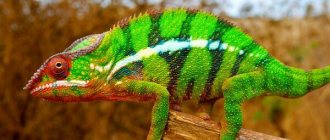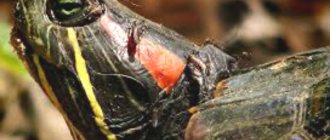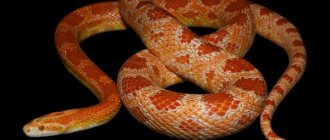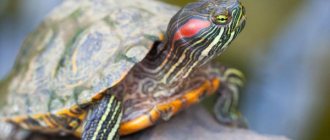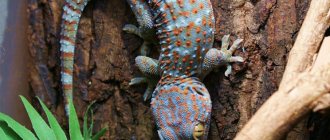- Wild animals
- >>
- Reptiles
Chameleons are one of the most amazing and unusual representatives of the animal world. The Yemen chameleon is one of the largest and most colorful species. It is these representatives of this type of reptile that lovers of exotic animals often keep, as they are characterized by high stress resistance and good adaptability to new living conditions. However, these amazing animals require the creation of certain living conditions, so before you get such an extraordinary animal, it is worth studying the features of its maintenance.
Origin of the species and description
Photo: Yemen chameleon
Yemen chameleons are representatives of chordate reptiles, belong to the order Squamate, suborder of lizards, classified in the family Chameleons, the genus and species of true chameleons.
Chameleons are one of the most ancient reptiles on earth. Zoological researchers described finds that, in their opinion, are already about a hundred million years old. The most ancient remains of the Yemeni chameleon were discovered in Europe. They indicate that these reptiles existed on earth more than 25 million years ago.
Video: Yemen chameleon
In addition, the remains of reptiles have been discovered in Asia and Africa. They indicate that in ancient times the habitat of these representatives of the animal world was much wider, and the animals were distributed on different continents. Zoologists suggest that modern Madagascar was home to many species of chameleon.
Previously, the ancient inhabitants of Yemen assumed that ordinary chameleons lived on their territory, which were later identified as a separate species.
This lizard got its name due to its habitat – the southern part of the Arabian Peninsula of Yemen. This is the first subspecies that was successfully bred in Russia at home in terrariums. Since the 80s, this subspecies has become the most popular and in demand among exotic animal breeders.
Further reading[edit]
- Andrews, R. M. (2008). Effect of incubation temperature on the growth and performance of the cloaked chameleon (Chamaeleo calyptratus). Journal of Experimental Zoology Part A: Environmental Genetics and Physiology
309(8), 435-46. - Herrel, A., et al. (2014). The scaly tongue projection of a cloaked chameleon, Chamaeleo calyptratus. Zoology
117 227-36. - McCartney, K.L. et al. (2014). Effects of carotenoid supplementation on immune system development in juvenile male veiled chameleons (Chamaeleo calyptratus). Frontiers of Zoology
11 26.
Appearance and features
Photo: Yemen chameleon female
This subspecies of chameleons is considered the largest and incredibly beautiful. The body length of adult individuals reaches 45-55 centimeters. These reptiles exhibit pronounced sexual dimorphism. Female individuals are about a third smaller in size.
A distinctive feature of the Yemeni chameleon is its rather large crest, for which it is called the veil chameleon, or helmet-bearer. From a distance, the crest really resembles a helmet covering the head of a lizard. It reaches a height of up to ten centimeters.
Juveniles have a rich, bright green color. Reptiles tend to change color. Adults change color if they feel stressed, females during pregnancy, or males during mating when females approach. Green can change to brown, blue, white, dark brown. As they grow older, the color of lizards changes. Stripes of bright yellow or orange appear on the body of animals.
Interesting fact. Zoologists say that color depends on social status. Lizards that grew up alone have a paler hue than individuals that grew up in a group.
The animals' limbs are thin and long, perfectly adapted for crawling through trees and grasping branches. The tail is quite long, thicker at the base, becoming thin towards the tip. Chameleons often roll it into a ball when they sit motionless on tree branches. The tail is very important; it serves as a support and is involved in preserving and maintaining balance.
Chameleons have an amazing eye structure. They can rotate 360 degrees, providing full visibility around. Vision is designed in such a way that with the help of the eyes you can accurately determine the distance to a potential victim.
The tongue of Yemeni chameleons is long and thin. Its length is about 20-23 centimeters. The tongue has a sticky surface that allows it to grasp and hold prey. At the tip of the tongue there is a kind of suction cup that attracts insects and prevents them from escaping.
Feeding process
There are several simple ways to feed your pet.
Among them:
You can feed food by hand or using tweezers. This feeding option is considered the most optimal, since the owner can always control the pet’s appetite. To do this, the insects are held with tweezers and presented to the reptiles in such a way that the chameleon does not touch the tweezers with its tongue. Otherwise, there is a risk of the ends of the device breaking off and falling into the animal’s mouth, which can cause breakage of teeth, which in chameleons will no longer grow. You can purchase special tweezers at the pet supply store, the tips of which are equipped with soft tips for feeding reptiles.
Using a feeder. Feeders are bought at pet stores or made independently from food-grade plastic (you can take used opaque containers of yogurt or sour cream). Such a feeder is coated inside with Vaseline (so that insects cannot escape from it) and securely attached to snags or twigs in the terrarium. The location of the feeder should also be convenient for the reptile to easily see and eat the food. When feeding live food into the feeder, it must first be coated in vitamins and nutritional supplements. It is necessary to regularly remove dead insects from the feeder.
Planting live food in a terrarium. This feeding method has its drawbacks: “food” can scatter throughout the terrarium and hide in various holes and crevices, after which it will be inaccessible to the pet; insects often die in a pond or drinking bowl, thus spoiling the water in them; “food” can escape from the terrarium and spread throughout the apartment
In the latter case, it is important to remember that crickets and cockroaches caught outside the terrarium can become infected with parasites or lead to chemical poisoning of the pet if there are insecticidal traps in the apartment.
Important! It happens that a chameleon, while feeding, grabs the tweezers with its tongue. In this case, do not jerk your hand sharply, as this may lead to injury to your pet’s tongue or its rupture.
If this does happen, an urgent consultation with a herpetologist is necessary. Offering your chameleon plant food is as follows:
- fruits are cut into pieces and fixed on branches cut from trees;
- You can feed by hand or serve with tweezers.
Video: how to feed a chameleon
Where does the Yemen chameleon live?
Photo: Adult Yemen chameleon
This representative of chordate reptiles lives in natural conditions exclusively on the Yemen Peninsula, the island of Madagascar, and Saudi Arabia. Lizards prefer damp forests, low bushes and thickets of various types of vegetation. However, zoologists say that the Yemeni chameleon also feels comfortable in dry regions, in mountainous areas.
It can easily be found where vegetation is very sparse, or, conversely, in the tropics or subtropics. This area of the globe is characterized by very diverse climatic conditions. The most numerous populations are located on the plateaus that lie between Yemen and Saudi Arabia. This part of the continent is characterized by desert and lack of vegetation diversity, however, chameleons choose coastal areas in which they feel most comfortable.
Later, the mammals were brought to Florida and the Hawaiian Islands, where they took root well and quickly acclimatized.
Lizards love to spend a lot of time on the branches of trees and bushes. However, with a large variety, it selects the most liked types of vegetation from the available species. These include acacia, succulent and cactus plants and shrubs of the euphorbia family. Lizards often settle near human settlements, choosing gardens and park thickets.
Habitat in nature
As you can easily guess from the name, the homeland of the chameleon is Yemen and Saudi Arabia. Although these countries are considered desert, chameleons live in coastal areas that regularly receive heavy rainfall and in drier valleys, but with plenty of greenery and water. Also introduced and established on the island of Maui (Hawaii) and Florida.
In the past, Yemen chameleons were rarely seen in captivity, as wild ones did not take well to even experienced terrarium keepers. However, over time, individuals bred in captivity were obtained that were much more adapted. So most of the Yemeni chameleons found on sale are locally bred.
What does the Yemen chameleon eat?
Photo: Male Yemen chameleon
The basis of the diet of reptiles is small insects or other living creatures. To catch prey, they have to hunt. To do this, reptiles climb onto a secluded branch of bushes or trees and freeze for a long time, waiting for the right moment. At the moment of waiting, the lizard’s body is completely immobilized, only the eyeballs rotate.
At such a moment, it is extremely difficult, almost impossible, to notice a chameleon in the foliage. When prey approaches at a sufficiently close distance, it throws out a tongue with a suction cup at the end and captures the prey. If they come across large prey, they capture it with their entire mouth.
Interesting fact. The Yemen chameleon is the only representative of this species that, after reaching sexual maturity, almost completely switches to feeding on vegetation.
What is included in the diet of Yemen chameleons:
- Butterflies;
- Grasshoppers;
- Spiders;
- Small lizards;
- Centipedes;
- Crickets;
- Beetles;
- Small rodents;
- Food of plant origin.
Surprisingly, it is Yemen chameleons that are herbivores. They eat ripe fruits, as well as juicy leaves and young shoots of various vegetation. When kept in artificial conditions, reptiles happily eat pears, apples, zucchini, peppers, clover leaves, dandelion, and other vegetation.
To replenish the body's need for fluid, reptiles lick droplets of morning dew from vegetation. That is why it is very important when keeping a reptile in artificial conditions that it is necessary to irrigate the terrarium and all surfaces with water to provide the lizards with a source of liquid. A prerequisite is to ensure the supply of calcium and vitamins necessary for the full functioning of Yemeni chameleons.
How to keep
The size of the terrarium can be 50 x 50 cm (width, length) and 120 cm in height. For females, a slightly smaller terrarium is suitable, but for a larger reptile it should be slightly larger.
The temperature inside the terrarium during the daytime should not fall below +28°C, optimally - + 30? +32 °C. Night temperature should be +22? +24°C, so place the animal’s house in a warm place where there are no drafts - they are very dangerous for the lizard.
It’s good if the terrarium is spacious. Then, at its different levels, the animal will find the most comfortable place for itself. Inside, decorate your reptile's room with potted plants. You can put treated driftwood on which the chameleon will climb. He also needs a small pond, take care of that too.
It is also necessary to make a small pump inside the terrarium, which will create a stream of supply water. After all, these reptiles in the wild drink water only from the leaves of plants, which lies on them in droplets.
In addition to temperature, it is important to observe the light regime - natural, artificial or combined. The duration of daylight should be at least 12 hours.
In the summer, during the daytime, take the cage with the adult reptile outside. The reptile will happily feast on flying insects. To attract them, you can place rotten fruits next to the enclosure. If the nights are warm, you can leave the chameleon's cage outside or keep the animal in an outdoor enclosure during this time. Of course, it is necessary that it have a roof that would protect it from precipitation.
Features of character and lifestyle
Photo: Yemen chameleon
Reptiles tend to spend most of their time on bushes or trees. They descend to the surface of the earth if they want to change their habitat or need to hide in extreme heat under stones or other shelters. They go hunting to find food during daylight hours. For these purposes, thick, long branches are chosen. When choosing a place and position for hunting, it tries as much as possible to get close to the stem or trunk at a distance of at least three meters. At night and during daytime rest, they climb onto thin branches of trees and bushes.
Male individuals tend to show aggression towards other individuals that appear on their territory. Natural instinct motivates them to protect and defend their territory. Yemeni chameleons seek to frighten their potential enemy, forcing him to voluntarily leave foreign territory. Opponents swell, hiss menacingly, fall flat on a hard, flat surface, open their mouths, nod their heads, curl and unfurl their tails.
During the confrontation, the reptiles slowly sway their bodies from side to side and change color. If such attempts to frighten the enemy are unsuccessful, then you have to resort to fighting. During the fighting, the reptiles inflict serious injuries and mutilations on each other. In rare cases, such collisions can result in death.
This happens when the weaker enemy has no way to retreat. Starting from the age of four months, males can show aggression towards each other. Females are distinguished by a humble disposition and do not show aggression towards their comrades.
Behavior
Representatives of this species lead an arboreal way of life. They descend to the soil surface in exceptional cases, when they need to change the location of their habitat or hide from extreme heat in burrows or under stones. During the day they hunt on thick branches closer to the trunks at a height of up to 3 m, and at night and for daytime sleep they climb up to the thinnest branches.
Males are staunch hermits and fiercely defend the boundaries of their home ranges from the encroachments of competitors. When confronted, they try in every possible way to scare the enemy. The duelists inflate their throat sacs, lie flat on a hard surface, nod their heads with their mouths open, and curl and unfurl their tails. Threats are accompanied by a characteristic hissing sound.
Chameleons slowly swing their bodies and become covered in bright colors. If such a show of force does not produce the desired effect, a fight is inevitable.
It could end in serious injury to one of the fighters. Most often this happens when the weaker male has no escape route. Males become aggressive towards each other already at the age of 4 months.
Females are distinguished by their flexible character and are loyal to their companions. Clashes between them are very rare.
Social structure and reproduction
Photo: Animal Yemen chameleon
The period of sexual maturity in Yemen chameleons begins when they reach one to two years of age. The mating period depends on climatic conditions and in most cases occurs from April to September. With the onset of the mating season, each male tries to attract the attention of the female he likes. To do this, he nods his head, slowly swings his whole body, curls and unfurls his tail. During this period, males tend to change color to bright and rich.
The female, who is ready to create a pair, is covered with a turquoise color on her back. She calls for the male she likes with her open mouth. Anyone she doesn't like, she desperately drives away.
Individuals mate for 15-30 minutes several times a day for 3-5 days. Then the pair breaks up, and the male leaves to look for another pair to enter into mating relations. In some cases, the period of marital relations lasts up to 10-15 days.
Pregnancy in females lasts from 30 to 45 days. During this period of time, females have turquoise or yellow spots on their bodies on a dark green or black background. At the end of the pregnancy, the female makes a long, tunnel-shaped hole, into which she lays several dozen eggs and carefully closes the entrance to the hole. The incubation period lasts 150-200 days.
The sex of hatched chameleons depends on the ambient temperature. If the temperature is approximately 28 degrees, then predominantly female individuals will hatch from the eggs, and if the temperature reaches 30 degrees, then predominantly male individuals will hatch. All babies are born at the same time. Their body length is 5-7 centimeters. The average life expectancy in natural conditions is 4-7 years.
Breeding
They become sexually mature at the age of 9-12 months. If you place a suitable partner with them, then it is quite possible to get offspring.
Usually, a planted female causes activity and mating games in the male, but you need to make sure that there is no aggression.
If the female is ready, she will allow the male to court her and mate. They can mate several times until the color changes to dark, indicating that she is pregnant.
The dark color of the female is a signal to the male that he should not touch her. And she becomes very aggressive at this time.
After about a month, the female will begin to look for a place where she will lay eggs. She sinks to the bottom of the terrarium and looks for a place to burrow.
As soon as you notice this, add a container of moist vermiculite or fiber to the terrarium.
The mixture should allow the female to dig a hole without crumbling. Moreover, the container should be large enough, at least 30 by 30 cm. The female can lay up to 85 eggs.
They will incubate at 27-28 degrees for 5 to 10 months. You can transfer the eggs to an incubator, where it will be easier to monitor them and remove unfertilized ones.
Natural enemies of Yemen chameleons
Photo: Yemen chameleon adult
When living in natural conditions, Yemeni chameleons have quite a lot of enemies. They become prey to larger, stronger and more cunning predators.
Enemies of lizards:
- Snakes;
- Large carnivorous mammals;
- Larger reptiles, lizards;
- Feathered predators - ravens, herons.
The peculiarity of the chameleon is that instead of hiding and running away, it is naturally endowed with the ability to try to scare a possible enemy. That is why, when a deadly enemy approaches, the lizard swells and hisses, which betrays itself even more.
Zoologists call parasitic worms the enemies of Yemeni chameleons. When they appear in a lizard’s body, they multiply quite quickly, which leads to weakening and exhaustion of the body. In some cases, the number of parasites is so great that they literally eat the lizard alive.
It is worth noting that lizards are very sensitive to lack of fluid, vitamin deficiencies, and lack of calcium. When dehydrated, the eyes of Yemen chameleons are constantly closed during the daytime.
Humans have made a significant contribution to the reduction in the number of reptiles. This is due to the development of ever new territories, destruction and destruction of their natural habitat. Deforestation and expansion of agricultural land lead to a reduction in the number of species of flora and fauna.
Self-defense
Camouflage coloring not only helps the chameleon remain invisible while hunting, but is also an excellent defense against enemies. The change in color of chameleons is associated with the structural features of their integument. The outer layer of the skin of these animals contains chromatophores - cells with grains of dark brown, reddish and yellow pigment. When the processes of the chromatophores contract, the grains gather in the center of the cells, and the skin of the chameleon becomes whitish or yellow. When dark pigment is concentrated in the fibrous layer of the skin, it turns black. The appearance of other shades is caused by the combination of pigments of both layers. And green tones arise as a result of the refraction of rays in the surface layer, which contains guanine crystals that refract light. The reptile can also change the color of individual parts of its body.
Population and species status
Photo: Yemen chameleon female
Despite the fact that chameleons, like no other, know how to camouflage and hide, they cannot be guaranteed to be protected from complete extinction. At the moment, not only the helmet-bearing chameleon species is endangered, but also other subspecies. It is increasingly difficult for them to survive in natural conditions. Numerous diseases, destruction of eggs and young individuals, human activity, predators are all reasons for the decline in their population.
Yemen chameleons are successfully bred at home in a terrarium, provided that optimal conditions are created and the required amount of food supply is created. It is this subspecies of lizards that is most in demand among breeders of exotic animals.
Zoologists claim that the bulk of the individuals existing today are kept in national parks and zoos, and not in natural conditions. Researchers confidently state that this species has not disappeared completely due to its ability to quickly adapt to new conditions, tolerate acclimatization well and eat plant foods. This allows you to breed them almost anywhere.
What is the price?
The most popular varieties of this lizard include those that not only have sizes from 20 cm, a wonderful color, but are also very popular among buyers. These are the following:
- Yemenite or helmeted - 1,800-12,000 rubles.
- Ordinary – 3,000-5,000 rubles.
- Deremensky – 4,000-6
- 000 rub.
- Fisher's Chameleon - 6,000-13,120 rubles.
- Meller's Chameleon - 12,000-45,000 rubles.
- Chameleon Verneri – 12,000 rubles.
- Calumma ambreense – 17,000 rub.
- Madagascar (Ambera) – 21,740 rubles.
- Madagascar short-horned – 17,500-28,500 rubles.
- Madagascar striped – 13,000-16,000 rubles.
- Globifer – 31,000 rub.
- Calumma linotum – 32,500 rub.
- Malta – 28,000-35,000 rubles.
- Madagascar long-nosed – 13,000-16,000 rubles.
- Madagascar Oshagnesi – 45,000 rubles.
The most expensive varieties of chameleons include the following:
- Parsoni - 60,000-200,000 rubles.
- Two-lane – 20,000-100,000 rubles.
- Damaran - 25,000-130,000 rubles.
Diet
Like most lizards, the Chameleon's diet consists of insects. Usually they give crickets, marbled and Madagascar cockroaches, less often beetles, butterflies and grasshoppers, small lizards and snakes. But any worms are strictly contraindicated for them - they are too fat for pets.
A small portion of products of plant origin will also not hurt; it is with them that you should start feeding, moving on to live food later. The leaves and fruits of tangerines, oranges, cherries, grapes, kiwi, persimmons are suitable; dandelion, lettuce, and soft vegetables are also good.
You need to feed the Chameleon twice a day, dipping the insects in a vitamin-calcium mixture for reptiles.
Occasionally you can pamper your pet (adult only) with newborn mice.
There is no need to be afraid that your pet will accidentally eat a bee or wasp; the Chameleon never catches stinging or poisonous creatures.
Rules of care
Upon reaching sexual maturity, the Yemen helmeted chameleon should be kept in a terrarium separately from other individuals. This is done to reduce the likelihood of stress and conflict. Two males cannot live in one place; they are too selfish and do not accept competition.
It is necessary to observe conditions of detention close to natural ones. There are many factors at play here:
- ventilation;
- terrarium size;
- priming;
- place to relax.
The size of the terrarium should be as large as possible, because some individuals can grow up to 60 cm in length. The ideal container would be at least 80 cm high and 40 cm wide. For a female, you can choose a smaller house, but in a larger one she will feel more confident and comfortable.
The size of the terrarium should be large, because some chameleons can grow up to 60 cm in length.
If the reptile was bought very small, then you need to be prepared for the fact that you will have to purchase a new house of a much larger size. The opinion that keeping a chameleon in a small terrarium leads to stunted growth is incorrect. The animal will grow up, but sick and constantly suffering from lack of space.
The inside of the house should be decorated with branches and various plants, where the pet can hide from prying eyes and relax. But the entire structure must be extremely reliable; the chameleon could not damage its skin or paws. The ideal option would be to use ficus or dracaena. It is better not to install artificial plants - dust will collect on them, and they will be of little use to the pet. But fresh flowers will additionally regulate the temperature and humidity in the terrarium.
Lighting
The comfortable keeping of this pet depends not only on the volume of the terrarium, but also on many other factors. So, they include:
- Lighting.
- Heating.
So, for this purpose, experienced aquarists recommend using 2 types of lamps. The first is used exclusively for lighting, and the second for heating. But it is worth noting that it is the ultraviolet lamp that has proven itself to be ideal as the latter, allowing the pet to fully absorb calcium. As for its placement, it is best to place it in an uncluttered corner.
In addition, auxiliary conditions for its maintenance include maintaining the temperature within 27-29 degrees, and in the heating zone 32-35. In this case, in an artificial reservoir, places with different temperature conditions are obtained, which the Yemeni chameleon can choose both for spending its leisure time and for relaxation.
Interesting Facts
- The Yemen chameleon is one of the most aggressive and largest species in the entire chameleon family.
- It is known that the tongue of this reptile is often 1.5-2 times longer than its entire body. Its structure is such that in the resting position it is located in the mouth, held by the cartilaginous bone of the lower jaw. At the moment of attack on prey, the lingual muscle tenses and, with the help of cartilage, the organ is sharply pushed out, then it relaxes, and the lizard pulls it back into the mouth.
- The Yemen chameleon is the most common species among reptile enthusiasts. Every day, all over the world, a huge number of these animals are sold.
It received its name from the region where the species was originally described—the western coast of Yemen, where it still lives. They also inhabit the Arabian Peninsula on the southwestern coast of Saudi Arabia in the wild. They live on the branches of various types of tropical trees.
